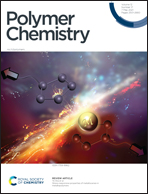Synthesis of fully degradable cationic polymers with various topological structures via postpolymerization modification by using thio-bromo “click” reaction†
Abstract
Synthesis of cationic polymers possessing significant therapeutic potential is of tremendous research interest. Here, we report a facile synthesis of poly(ε-caprolactone) (PCL) based cationic polymers with controlled topological structures and tunable charge densities via postpolymerization modification using thio-bromo “click” chemistry. Three types of polymeric precursors were prepared by ring-opening polymerization (ROP) or combination of ROP and azide–alkyne click reaction, including linear homopolymer poly(α-bromo-ε-caprolactone) (P(CL-Br)), block copolymer PCL-b-P(CL-Br), and bottlebrush polymer PCL-g-(PCL-b-P(CL-Br)), and then the P(CL-Br) blocks or segments were modified using the thio-bromo click reaction with a thiol bearing a tertiary amino group, yielding the corresponding cationic polymers, respectively. Size exclusion chromatography (SEC) and 1H NMR characterization demonstrated successful synthesis of the cationic polymers with controlled molecular weights and topological structures that may have great potential for biomedical applications.



 Please wait while we load your content...
Please wait while we load your content...